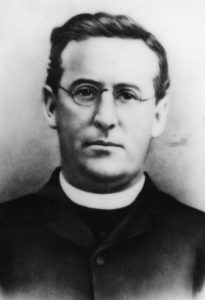History of The Josephite Harvest Magazine
1888-Today

The Josephite Harvest began as an annual issue called The Colored Harvest. It was first published in 1888. Its beginning announced the opening of St Joseph’s Seminary in Baltimore, Maryland, and asked support for this new American missionary institution. Until then, American candidates for St. Joseph’s Foreign Mission Society traveled to Mill Hill, England, for their seminary studies. After ordination, they would return as priests to staff the few Mill Hill Josephite parishes serving black people.
The Colored Harvest and St. Joseph’s Seminary grew together. Both existed to foster evangelization with America’s black population. The preeminent spokesman for the cause of black evangelization was the editor of the Harvest and (also) rector of St. Joseph’s Seminary, Father John R. Slattery. Under his guidance The Colored Harvest grew from an annual issue to become, in 1895, a quarterly magazine, published in January, March, June and October.
To promote the distribution of the magazine and to enlist support for the new seminary and Josephite missions, Father Slattery gathered a group known as ‘Zealators’, who solicited subscriptions for The Harvest among their friends, neighbors and fellow workers. In those first years, the annual subscription rate was Twenty-Five Cents!
The 1890s in the United States had several prominent language groups. Canada, our neighbor to the north, had a large French-speaking population. To reach this multi-language Catholic population, The Colored Harvest was also published in French, German and Italian.
By 1893, The Colored Harvest was five years old and had 4,000 subscribers. By 1895, many thousands more copies were printed and distributed in various ways. According to Josephite records, 10,000 copies were sent at certain times to each of three major cities: New York City, Brooklyn and Chicago for distribution in larger parishes. Father Slattery, at that time, wrote that The Harvest was being distributed all over the United States and Canada, as well as in England, Ireland and Europe, Australia and New Zealand. He also wrote that “every Catholic priest in the United States is sent a copy.”
Father Slattery’s goal as editor and rector was to gain support for Black Evangelization.
Devotion to St. Joseph, patron of the Society and of the seminary, was fostered among the readers of The Harvest from the very first issue. Nearly every issue of the magazine carried an article in praise of St. Joseph. Prominent among the devotions was the Thirty Days Prayer to St. Joseph, especially on the days leading to his feast on March 19. That special devotion, begun nearly more than a hundred years ago, still flourishes among today’s readers and benefactors of The Josephite Harvest. Today, over 400,000 Thirty Days Prayer leaflets are distributed to our readers, every year.
In 1922, The Colored Harvest became a bimonthly magazine. From 1948 to 1962, the magazine was published, each month, with the exception of the July-August edition as a bimonthly. Today, the circulation is approximately 40,000 copies per issue and the magazine is published quarterly: Spring, Summer, Autumn and Winter.
By the 1960s, the American people had a raised consciousness for the cause of civil rights, social justice and black identity. To reflect this and to give greater identity to the sponsoring Society and our continuing devotion to St. Joseph, the magazine’s name was changed to The Josephite Harvest, beginning with the October 1960 issue. The magazine continued with its original purpose: support for the Josephite Society’s promotion of Black Evangelization.
The articles and editorials, published in The Harvest through these 125 years, reflect the continuing effort of the Josephite Society to inform our readers and benefactors about the state of the Church and Black America. In its own words, The Harvest had been a prophetic voice, anticipating for decades the powerful and moving words of Pope Paul VI that “the Church is an evangelizer, but she begins by being evangelized herself…. The Second Vatican Council and the 1974 Synod at Rome vigorously took up again this theme of the Church which is evangelized by constant conversion and renewal, in order to evangelize the world with credibility” (Evangelii Nuntiandi: On Evangelization in the Modern World).

